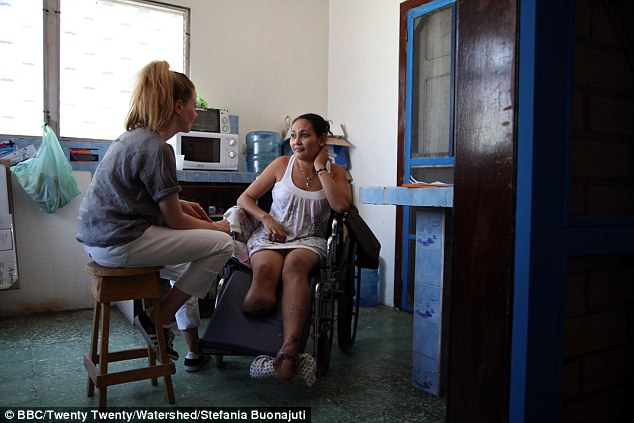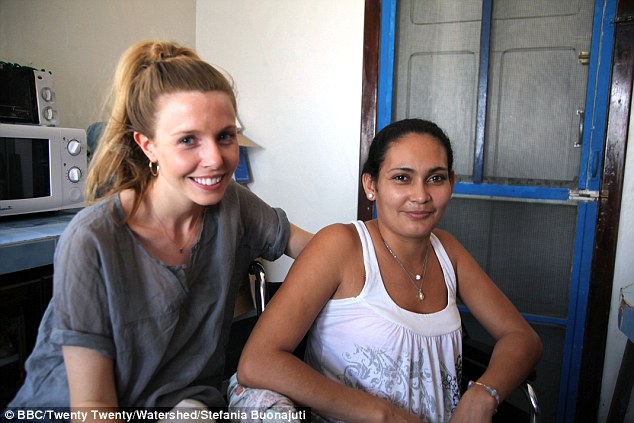The threat of death by violence is real in Honduras, especially for women as murder is the leading cause of death in the Central American country. San Pedro Sula resident Heydi Hernandez knows this all too well as she was brutally attacked by her husband, barely surviving after he hacked off part of both her legs with a machete after she threatened to leave him.
A new BBC3 documentary led by investigative journalist Stacey Dooley and set to air October 26 takes a closer look at the scariest and most dangerous places to be a woman, with the newest episode focusing on the barbaric acts of violence routinely committed in Honduras, reports the Daily Mail.
Dooley met with Hernandez, who’s a mother to two children, to discuss what it’s like to live in Honduras’s most violent city.

Credit: BBC/Twenty Twenty/Watershed/Stefania Buonajuti
“Heydi revealed how she was subjected to an agonising ordeal in which she lost both her feet, yet is actually one of the lucky ones – as few women attacked in the crime-riddled country live to tell the tale.”
Hernandez described to Dooley the day she was attacked.

Credit: BBC/Twenty Twenty/Watershed/Stefania Buonajuti
“I had gone to visit my dad and when I got home my husband said he was tired of being with me. I told him, ‘if you’re [sic] are tired of being with me, then let me leave,’” she said.
Mother repeatedly hacked with machete despite her pleas for mercy
“That’s when I saw him pull a machete from under the bed. He said, ‘I am not going to let you leave me.’ He grabbed me by the arm and that’s when he hacked me. He kept going as I cried no.”
Miraculously, Hernandez survived “following a life-saving surgery;” however, she’s barred from ever walking again as she lost one foot at the ankle and the other leg at mid-calf.
The worst part about the ruthless violence in many Central American cities is that the perpetrators often go unpunished due a corrupt criminal justice system and government that’s easily influenced by powerful members of the cartel.
Hernandez desperately wants justice against her attacker; however, she says it’s unlikely unless you can afford an attorney. Dooley later learned that Hernandez’s attacker could have his charges reduced to grievous bodily harm (GBH), and if convicted may only serve two years in prison.
Highest murder rate in the world
Unfortunately, Hernandez’s story is not unique. The Overseas Security Advisory Council (OSAC) rates the country’s crime rating as “critical,” noting that since 2010, Honduras has the highest murder rates in the world.
Home to about eight million people, Honduras has an estimated 7,000 street gang members, Mara Salvatrucha (MS-13) being the most powerful, who often specialize in “murder-for-hire, carjacking, extortion, and other violent street crime.”
Gangs are also known to control taxi services in Honduras, putting tourists and other innocent travelers at risk.
Even children are subjected to merciless acts of violence that’s “largely perpetuated by gangs and other forms of organized crime,” according to Human Rights Watch.
Approximately 458 children were murdered in Honduras between 2010 and 2013, according to the National Human Rights Commission (CONADEH). Just four months into 2014, 270 people under the age of 23 were killed, reports Jose Guadalupe Ruelas, an international children’s charity.
Inescapable violence pushing Hondurans into the U.S.
Soaring crime rates are largely connected with an enormous jump in Honduran immigrants entering into the U.S., most of them illegally. In the 1930s, the number of Hondurans migrating to the U.S. will close to zero; however, those numbers have continued to rise significantly beginning in the 1960s, according to reports.
By the year 2000, close to 300,000 Honduran immigrants were entering into the U.S. legally. By 2008, an estimated 1 million resided in the U.S., most of them illegally.
The increase in Hondurans migrating to the U.S. during the first decade of the twenty-first century was the largest of any immigrant group.
Additional sources:
DailyMail.co.uk
HRW.org
OSAC.gov
ImmigrationToUnitedStates.org





















